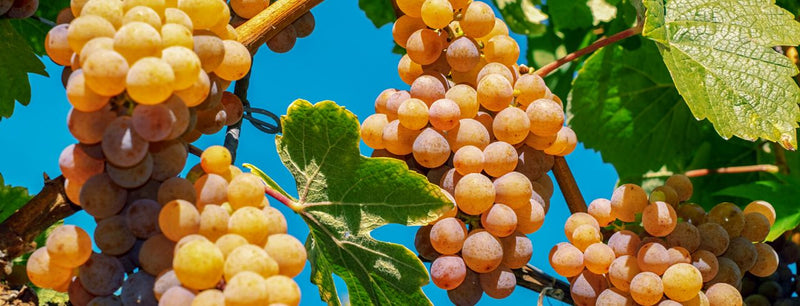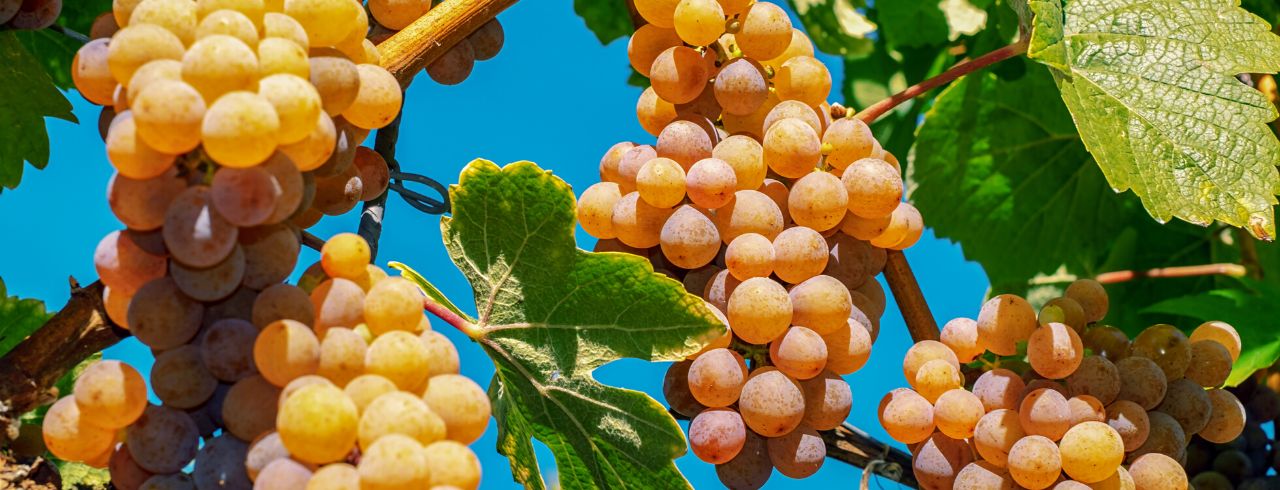
A Comprehensive Guide to White Wine
Wines come in so many flavors, with thousands of subtle differences, accents, and notes in the taste, that no two wines are precisely the same. Even yearly vintages taste different (have you ever heard someone say, “oh, that was a really good year for that wine”?).
All that said, everyone can name two overarching categories of wine: red wine and white wine.
Red wines often represent stronger, bolder tastes with solid and rich flavors. In contrast, white wines often represent the more acidic, floral, and fruity aspect of wine that narrows in on lighter flavors and subtle overtones.
Most casual wine drinkers don’t realize the vast differences between red and white wines, simply assuming the distinctions all boil down to the fact that different grapes are used. Indeed, the two types of a wine generally use different types of grapes.
However, they also utilize different parts of the grape, processes, and chemical compounds (which correspond directly to a wine’s nutrition component), all of which combine to give white wines their unique taste.
This guide will cover these differences in greater depth, exploring what makes red and white wines different. Then, we’ll explore the different types of white wine and how winemakers can create bold, unique, and flavorful tastes from the first planting of the grape to the final bottle.
Different Grapes
Mostly, red wine is made with red grapes, while white wine is made with white (green) grapes. However, many people don’t realize that winemakers utilize different grape parts for different wines.
When red wine is made, the wine is fermented with the skin and seeds of the grapes. This is because the color of the grapes, and thus the wine, is held within the skin and the seed.
On the other hand, white wine is made without grape skin and seeds (except in special situations). Some white wines, such as White Pinot Noir, are made with red grapes. Winemakers remove the skins and seeds from the grapes, allowing them to craft a white wine taste that is richer and bolder than many other white wines.
Different Production Methods
The production methods used to make white wine feature several key differences from those used to produce red wine.
By far, the most significant difference between the two production methods is the type of taste winemakers are trying to achieve.
As noted above, red wines typically follow different taste guidelines than white wines. The rich, bold, and strong flavors of red wine are achieved by increasing oxygen exposure, which rids the fruity's wine, florally overtones intrinsic to the grapes.
To attain this increased oxygen exposure, red wine is typically aged in oak barrels since the wood's pores allow oxygen to circulate through the wine.
On the other hand, the taste guidelines of white wine typically revolve around the same floral, fruity, and citrusy tastes that winemakers seek to rid red wine of. As a result, white wine is often aged in stainless steel containers or vats, which allow winemakers to control oxygen exposure, an essential component of the white wine production process.
Again, this difference is not true of all red and white wines, but it is very common.
White Wine Making Process
The basic outline for white winemaking is as follows:
- Grow grapes: This seems self-explanatory enough, but the quality of grapes will have, for the most part, a greater impact on the quality of the wine than any of the other steps.
- Harvest the grapes: Wineries harvest grapes during different times of the year depending on their location; those north of the equator typically harvest during August, September, and October, while those south of the equator typically harvest during any of the months from February to April.
- Pressing: In this step, the wine grapes are pressed to extract the juice from the seeds and the skins. This is an essential part of the white wine process because, if you recall from above, white wine has to be fermented without grape skins and seeds, unlike red wine.
- Settling: Settling is an important part of the winemaking process because it allows the sediments from the grapes to settle out of the juice. This is important because clear juice makes for better wine.
- Fermentation: Yeast and grape juice combine to create alcohol and CO2, a significant chemical reaction for wine production. This process typically takes longer for white wines than red wines because they must be kept at cooler temperatures.
- Aging: After the fermentation process is complete, white wines will typically undergo further aging. This aging can be done through several methods. Aging can be continued in stainless steel vats, often used to limit oxygen exposure, or in oak barrels, which increases oxygen exposure and allows winemakers to instill several different tasting notes in the wines.
- Preservatives: Sulfur dioxide (SO2) is often added to wine preservatives to prevent spoilage. Recently, some winemakers have begun practicing natural winemaking where no preservative is added.
- Filtration: The filtration process removes the wine of any remaining sediment from the production process. Without this step, white wines would look cloudy rather than having the clear, transparent, yellowish color they are known for.
- Bottling: This is the final step in the process. Here the wine is finally placed in its iconic bottle. Then, it can finally be transported and shipped directly to you!
Interesting Fact: As a rule, steps #3 and $5 above are typically reversed for red wines. Winemakers will ferment first and then press.
7 White Varietals: An Extensive White Wines List
White wine comes in several different varietals. A few commonly known and popular ones consist of Chardonnay, Pinot Grigio, and Riesling, though there are dozens of white wine varietals that you likely haven’t even heard of before!
In this next section, we’ll cover a number of the most popular varietals, their common origins, popular pairings, and some of our favorite selections!
Chardonnay
- Notable Regions Grown: Burgundy, France, Central Valley, California, New Zealand
- Origin: Burgundy, France
- Sweetness: Dry
- Flavors: Apple, pineapple, vanilla, butter, crème brûlée
Chardonnay is the best-known and most popular white wine. The grape used to produce Chardonnay is extremely versatile, both with the flavors it can be instilled with and the different production methods available, allowing for Chardonnay to be one of the most widely grown grapes.
Chardonnay grapes can capture a vast range of flavors depending on the climate in which they’re grown and several other factors. Flavors include everything from apple and pineapple to vanilla, butter, and even crème brûlée.
Food Pairing with Chardonnay
Being a white wine, Chardonnay is often served before dinner or as the first wine of the meal. White wines are typically served before their heavier red counterparts to mirror the meal and balanced taste. Some common Chardonnay pairings are as follows:
- Meat: Roasted or grilled chicken and pork.
- Seafood: Crab and Grilled Salmon
- Cheese: Brie and Camembert
- Pasta: Served best with pasta that uses a cream sauce.

Moscato
- Notable Regions Grown: Asti, Italy, Australia
- Origin: The origins of Moscato can be traced back to Greece
- Sweetness: Semi-sweet
- Flavors: Orange, pear, lemon, and honeysuckle
Moscato is a popular white wine made from the Muscat family of grapes, which consists of over 200 varieties. Moscato wines are known for their sweet, citrus aromas that feature notes and flavors of orange, pear, lemon, and more. However, grapes can also be used to make dessert wines known for their sweet and rich caramel flavors. It is also one of the oldest wine grapes in the world.
Food Pairing with Moscato
Moscato is intended to be served chilled and pairs well with light, zesty salads, and a number of desserts, including apple and peach cobblers. Some common food pairings with Moscato include the following:
- Meat: Flank steak, chicken, and pork
- Seafood: Crab, fish
- Cheese: Goat cheese, brie
- Salad: Light, zesty salads that feature citrus and fruit flavors
- Desserts: Peach cobbler, apple cobbler, apple pie, key lime pie, sorbet

Pinot Grigio (Pinot Gris)
- Notable Regions Grown: Burgundy, France, Trentino, Italy, Australia, New Zealand, California
- Origin: The northwest Piedmont region of Italy
- Sweetness: Dry
- Flavors: Lemon, lime, pear, apple, nectarine, honeysuckle
Next to Chardonnay, Pinot Grigio should be at the top of any white wine chart. The wine grapes are considered mutant clones of the red wine grapes used for Pinot Noir, thus the name.
Around the world, Pinot Grigio is typically a full-bodied, dry wine. Still, several notable Pinot Grigio wines made in Italy are recognized for their seemingly lighter-bodied and acidic tastes.
Food Pairing with Pinot Grigio
Pinot Grigio pairs well with salad, seafood, and dishes that feature neutral, tamer flavors. The following are several popular combinations and pairings for Pinot Grigio wines:
- Meat: Grilled and roasted chicken and pork
- Seafood: Crab, Halibut, Trout, and scallops
- Cheese: Mozzarella and goat cheese
- Salad: Light, appetizer salads that are simple and traditional
- Desserts: Less-sweet desserts such as crème brûlée

Riesling
- Notable Regions Grown: Luxembourg, Germany, Italy, and Alsace, France
- Origin: The Rhine region of Germany
- Sweetness: Sweet
- Flavors: Apricot, lemon, lime, pear, and pineapple
Riesling wine grapes originate from the Rhine region of Germany. It is known for its flowery aromas and its acidic taste.
Winemakers seldom oak such wines to focus on the grapes' fruity and citrus flavors. The wine is grown throughout the world. However, it is the most common wine grape in Germany and Alsace, France.
Food Pairing with Riesling
Riesling is known for its rich sweetness and thus pairs well with several desserts. Like most white wines, it can also be served before meals. Here are several different foods you can pair a good bottle of Riesling with:
- Meat: Grilled and roasted chicken
- Seafood: Crab, scallops
- Cheese: Gouda
- Salad: Light salads that are zesty and simple.
- Desserts: Cherry pie, apple pie, apple strudel, cheesecake, crème brûlée
Sauvignon Blanc
- Notable Regions Grown: Chile, South Africa, Bordeaux, and California
- Origin: Bordeaux Region of France
- Sweetness: Dry
- Flavors: White peach, lime, and green apple
Sauvignon Blanc originates from the renowned French wine region of Bordeaux. The grape variety is now grown worldwide, producing a crisp, dry white wine. The taste of the wine varies greatly based on the climate in which it is grown, making Sauvignon Blanc slightly different in every region it is grown.
Food Pairing with Sauvignon Blanc
Sauvignon Blanc is a popular meal component, and pairs well with various dishes.
- Meat: Roasted and grilled chicken and pork
- Seafood: Smoked salmon
- Cheese: Gouda
- Salad: Light salads that are zesty and simple
- Vegetables: Asparagus, artichokes, brussels sprouts, zucchini

Sémillon
- Notable Regions Grown: France, Australia, South Africa, New Zealand
- Origin: West of France
- Sweetness: Dry
- Flavors: Lemon, green apple, and pear
Mainly made in France and Australia, Sémillon is another popular white wine varietal native to France’s Bordeaux region. Though today its popularity and prominence has fallen, Sémillon was thought to be the most planted grape in the world, with notable makers in regions outside of France and Australia, such as South Africa.
Food Pairing with Sémillon
Sémillon pairs well with several foods, notably spicy courses, which its mild-sweetness offsets. It also pairs well with several seafood dishes and makes for an intense aperitif wine.
- Meat: Chicken, pork, veal
- Seafood: Salmon, crab, shellfish
- Cheese: Goat cheese, blue cheese
- Salad: Salads with fruits and nuts, along with a zesty citrus dressing
- Vegetables: Asparagus, artichokes, Brussel sprouts, zucchini
White Wine Blends
White blends are winemakers’ way of ensuring quality and bringing their unique visions to life. Sometimes two, three, four, or even five grapes allow a winemaker's artistic expression to shine and truly bring the quality of the grapes out from one another.
While the popular white blends consist of White Bordeaux (Sémillon, Sauvignon Blanc, Muscadelle) and White Bourgogne (Chardonnay, Aligote), there are hundreds of other white wine blends out there that allow winemakers to show off their expertise.
Italy: Arbos Bianco - Made from a delightful mix of organic Riesling and Moscato grapes, Arbos Bianco is the versatile Italian white you want for your next meal or get-together. Pour a glass and find yourself enticed by the hints of jasmine and chamomile on the nose.
White Wine in a Nutshell
That may seem like a lot of information, but it is only the beginning.
It is also important to remember that while the above information provides a strong foundation and general guidelines, the way a wine taste has a great deal to do with its year and maker. For instance, a typically dry wine, such as Sémillon, can be made into a sweet wine with the proper techniques.
We don’t expect everyone to be a wine connoisseur! After all, the only thing that matters is your taste and preference. If you want to learn more, try exploring some of our other educational pieces on our blog. There’s a whole world of wine waiting to be explored!
Related Wines
- Calvari Organic White Blend Wine Details
- 2022 Entre Ciel Et Mer Vermentino wine
- Experience the Best Complex Red Wines
- Geoffrey's Guide to Dinner Party Wines
- Discover Rewild Sustainable Sauvignon Blanc 2023














